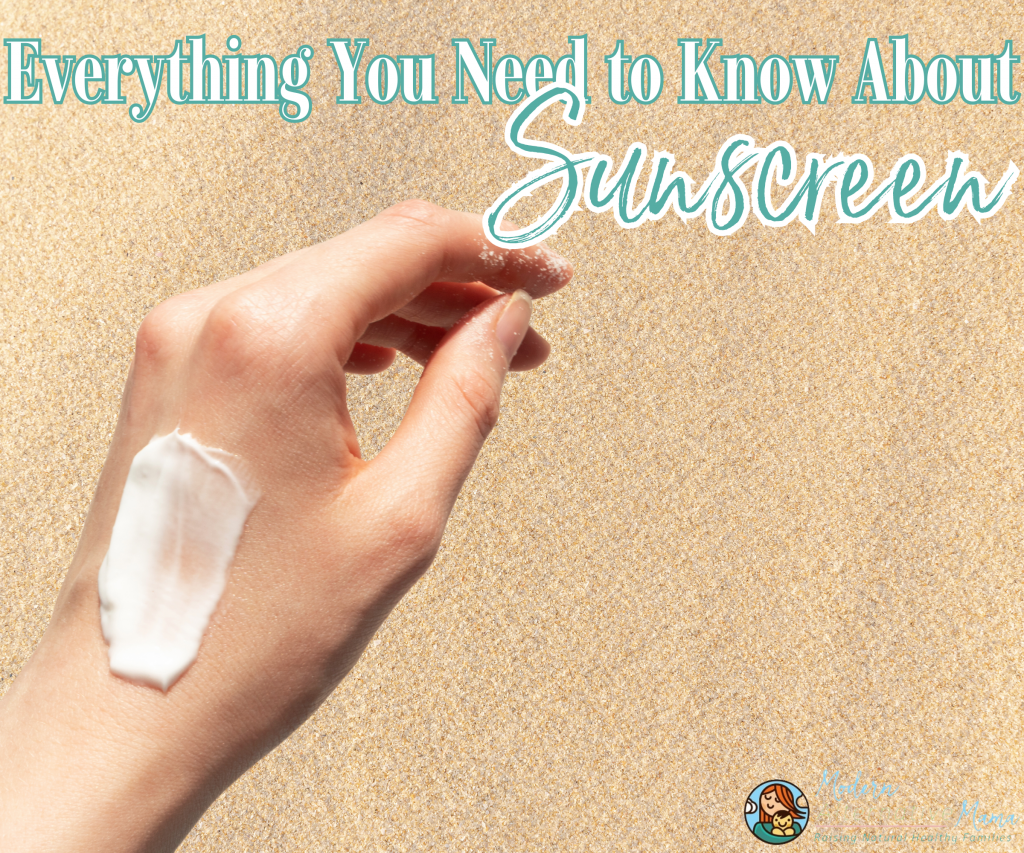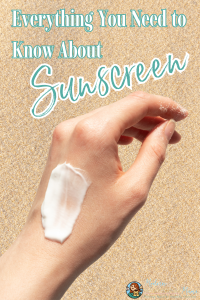Summertime is my favorite – beaches, hiking, picnics, and other sun-related activities. During the summertime, many toxins lurk around us. Bug repellants. Sunless tanners. Sunscreen. After-sun products. The list goes on. Commercial products are toxic to humans, the environment, and aquatic life.
Did you know certain ingredients found in sunscreens have been banned in many locations, including the U.S. Virgin Islands, Hawaii, Key West, Florida, Bonaire, Palau, and multiple Mexican vacation spots (1)? These ingredients can induce bleaching, damage DNA, deform, or even kill coral. These ingredients are so problematic that the Center for Biological Diversity has petitioned the Federal Drug Administration (FDA) to ban these coral-killing sunscreen ingredients nationally (2).
If you read our blog, What You Need to Know About Vitamin D, you know the mainstream has recommended avoiding mid-day sun to reduce the risk of sunburns for years.
Unfortunately, this is terrible advice. The UVA rays that can cause skin cancer and deep-level skin damage are always strong. The UVB rays that can cause sunburn also produce vitamin D in the skin and are strongest around mid-day. Why would you expose your skin to rays that can’t produce much vitamin D but can cause long-term damage? That makes no sense.
Additionally, exposure to sun rays isn’t always bad. In fact, exposure to these rays has shown to be particularly helpful in treating vitamin D deficiency, seasonal affective disorders, psoriasis, sarcoidosis, mycosis fungoides, and numerous other cutaneous conditions (3)
Vitamin D exposure is why it’s important to get 10-30 minutes of mid-day sunlight daily as many days per year as possible (until the skin turns pink). Remember, wearing sunscreen while you do this will block almost all UVB rays.
If you’re in the sun for longer, being cautious of your sunscreen is important because you don’t want toxic ingredients soaking into your skin.
Toxic Ingredients Found in Mainstream Sunscreen
There are so many gnarly ingredients in everyday products. This is a partial list of ingredients to watch out for. I have a growing list of common ingredients to avoid in my blog, .
Octocrylene
Although this ingredient is claimed to be a “pure” ingredient, it is often contaminated with benzophenone, a mutagen, carcinogen, and endocrine disruptor (4). Benzophenone is a class of benzophenones, more specifically, a formaldehyde in which both hydrogens are replaced by phenyl groups (5). short-term exposure to formaldehyde has been linked to coughing, headaches, dizziness, nausea, eye, nose, and throat irritation, while long-term exposure to formaldehyde may cause certain types of cancer (6).
Additionally, benzophenone accumulates over time from the degradation of octocrylene in mainstream sunscreen products. A study examined six sites in Brazil for the presence of octocrylene in the livers of 56 Franciscan dolphins. The dolphins were stranded or accidentally caught in fishing nets. The study found high concentrations of octocrylene in 21 dolphin livers.
Avobenzone
Avobenzone is an oil-soluble, light-sensitive ingredient derived from dibenzoylmethane (8). Oceanographers have found this petrochemical to damage marine and reef environments, increasing the rate of coral bleaching (9). According to Dibenzoylmethane Safety Data Sheet, you should “wash off immediately with soap and plenty of water while removing all contaminated clothes and shoes upon skin contact with this chemical. Get medical attention (10).” Aside from that, avobenzone degrades when sun exposure, releasing harmful free radicals into the body (11). Avobenzone can disrupt the endocrine system and can be found in the blood weeks after use (12).
Octinoxate
Octinoxate or octyl methoxycinnamate (OMC) is often marketed as “natural” despite being a mix of sulfuric acid and methanol, a petroleum by-product (13). This chemical is dangerous to beaches, aquatic life, and coral reefs. Octinoxate can also be found in some drinking water supplies (14). This ingredient is absorbed into the body quickly and has been detected in human urine, blood, and breast milk even after use (15). Octinoxate is an endocrine disruptor that mimics estrogen and can disrupt thyroid function (16).
Oxybenzone
Oxybenzone, known as benzophenone-3 amongst other names, is a chemical compound that blocks UV rays (17). This chemical releases toxins in the corals’ water, stressing their symbiotic partners. Stress awakens dormant viral infections in algae, causing the coral to expel the algae, which may lead to death (18). Oxybenzone also affects humans and is considered a hazardous eye irritant and allergen (19). Additionally, this ingredient can interfere with hormones and has been found in human breast milk, amniotic fluid, urine, and blood. Finally, children may be more vulnerable to the health hazards associated with oxybenzone (20).
Petroleum
Petroleum clogs pores and often causes acne breakouts as well as rashes. Petroleum has also been linked to estrogen dominance. Estrogen dominance is a common condition in which sufferers have a high ratio of estrogen, with little to no progesterone to balance its effects in the body (21).
Caprylyl Glycol
Caprylyl glycol is an alcohol derived from a fatty acid. It is a humectant that pulls water into the skin and helps to hold moisture into the skin. The problem is that caprylyl glycol can irritate some skin types, particularly those already sensitized or irritated (22).
Fragrances
Fragrances are derived from petrochemicals. These chemicals include benzene derivatives, aldehydes, phthalates, and many other known toxins capable of causing cancer, congenital disabilities, nervous-system disorders, and allergies. Learn more in our blog, Everything You Need to Know About Fragrance.
Dimethicone
Dimethicone is silicone-based, which you do not want. Why don’t you want a silicone-based product? Silicone-based products will form a barrier on top of your skin that can trap dirt, sweat, bacteria, sebum, dead skin cells, and other debris, and it can dehydrate your skin and
interfere with cell renewal, among other things (23).
Stearic Acid
Stearic acid may cause a few side effects, including eye irritation, skin irritation, gastrointestinal irritation like nausea, vomiting, diarrhea, and respiratory tract irritation (24).
How Toxic Ingredients Affect Aquatic Life
Now that we know how these ingredients affect human life let’s discuss sunscreen’s effect on aquatic life. While swimmers and snorkelers standing on or touching the fragile ecosystems present their own threat, an even more pressing danger has emerged: toxic chemicals from mainstream sunscreens. Mainstream sunscreens can bleach, damage, and kill coral reefs, preventing them from reforming and interfering with the reproduction of fish and turtles – harming the entire ocean (25)!
The most commonly banned sunscreen ingredients are octocrylene, avobenzone, octinoxate, and oxybenzone, and for good reason. Studies have found that these four petrochemical sunscreens are toxic to human health, coral reefs, and marine species.
Octocrylene, avobenzone, octinoxate, and oxybenzone aren’t the only toxic ingredients that can wreak havoc in the oceans. According to the National Ocean Service (NOAA), sunscreens’ ingredients can cause marine life problems: benzophenones, OD-PABA, 4-methyl benzylidene camphor, 3-benzylidene camphor, nano-titanium dioxide, and nano-zinc oxide.
The issue affects more than our beautiful coral reef systems; the NOAA details the following impacts on marine life exposed to toxic sunscreen ingredients (26):
- Green Algae: Can impair growth and photosynthesis.
- Coral: Accumulates in tissues. It can induce bleaching, damage DNA, deform young, and even kill.
- Mussels: Can induce defects in young.
- Sea Urchins: Can damage immune and reproductive systems and deform young.
- Fish: Can decrease fertility and reproduction and cause female characteristics in male fish.
- Dolphins: Can accumulate in the tissue and be transferred to young.
Non-Toxic Sunscreen Alternatives
You can use Earthley’s Sun Shield, a sun protectant lotion that provides a completely natural way of safeguarding your skin from sun damage. This lotion doesn’t absorb the sun’s rays or reflect them. Instead, it penetrates deeply into the skin to help prevent damage at the cellular level. Raspberry seed oil protects against UVA and UVB rays, while the oils and butters naturally have SPF ranging from 2 up to 50 SPF each. Sun Shield is NOT a sunscreen.
Fun fact: the U.S. Food & Drug Administration (FDA) considers sunscreen a nonprescription drug (27).
Depending on your skin type, you may prefer to pair this with a mineral-based sunscreen for particularly hot or sunny days, or you may find it to be enough protection on its own.
My top two mineral-based sunscreen recommendations are:
- Badger’s Natural Mineral Sunscreen sets the standard for simple safe sunscreens that protect you and your family. With nourishing and protecting properties and organic ingredients, this brand’s mineral sunscreens are ideal for long days in the sun. With a wide variety of options for babies, kids, and adults, this reef and human-friendly option will surely have something for everyone.
- Two Peas Organics’ All-Natural, Organic Mineral Sunscreen uses highly effective plant-derived and certified organic ingredients to provide superior biodegradable sun protection and coral reef safe. This sunscreen provides reliable SPF 30 broad spectrum UVA & UVB protection. Gentle enough for a baby’s sensitive skin yet strong enough coverage for kids and adults.








[…] >>Continue reading over at Modern Alternative Mama to find out about the ingredients to look … […]
We are getting ready to try Radiantly You sunscreen. Completely all natural! you can check it out here http://www.radiantlyyou.com/ErinRF
[…] (5) What to Look For in Non-Toxic Sunscreen https://modernalternativemama.com/2014/07/03/look-non-toxic-sunscreen/ […]